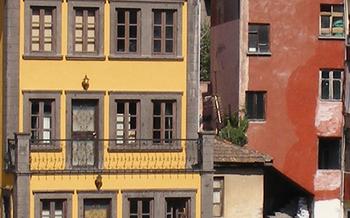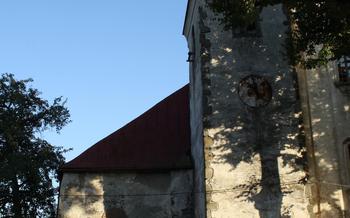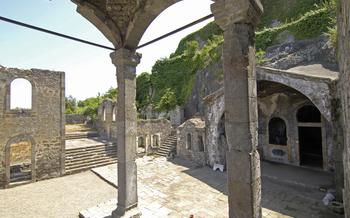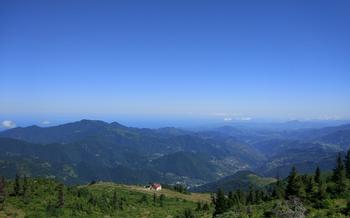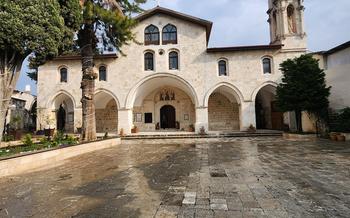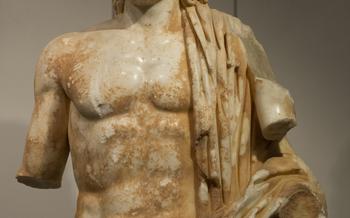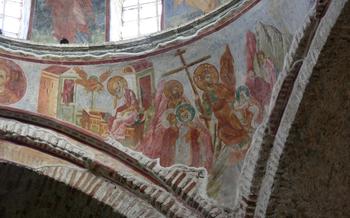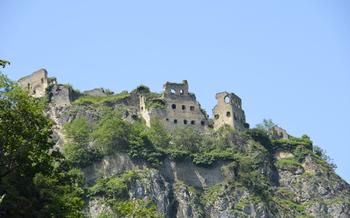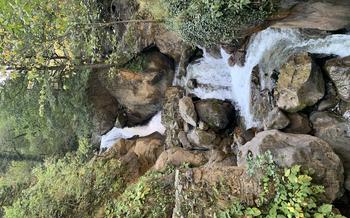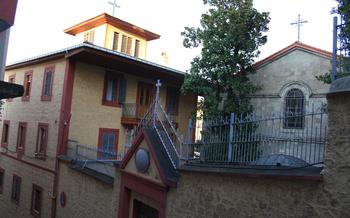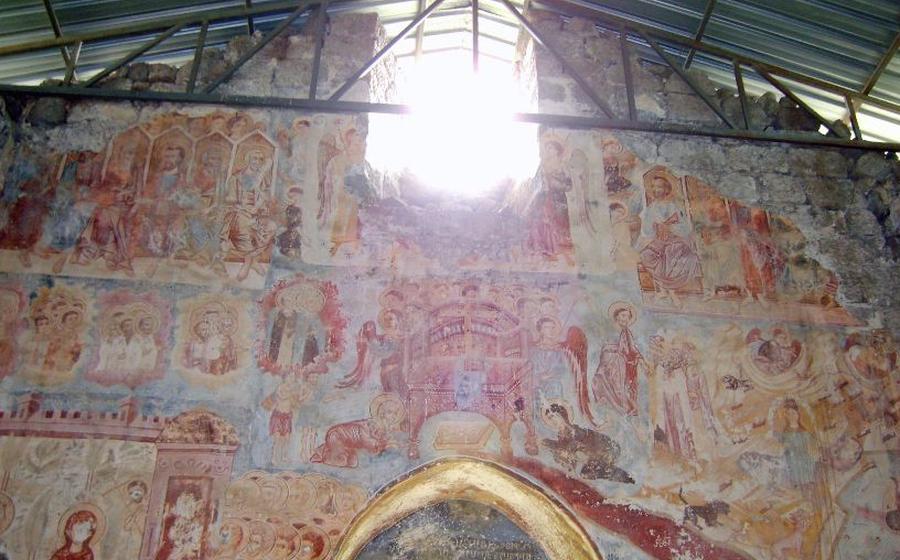
Kaymaklı Monastery
- Historical Significance
- Location and Access
- Architectural Features
- Exploration of the Monastery
- Religious Importance
- The Village of Kaymaklı
- Nearby Attractions
- Best Time to Visit
- Insider Tip
- Admission Fees and Hours
- Photography Tips
- Dress Code
- Food and Drinks
- Local Guides
- Accessibility
- Insider Tip: Discover Hidden Gems
Historical Significance
The Kaymaklı Monastery is a testament to the rich religious and cultural history of the Trabzon region. Founded in the 15th century by the Greek Orthodox community, the monastery played a crucial role as a center of faith and learning for centuries. Its strategic location on a hilltop overlooking the Black Sea made it a prominent landmark and a symbol of the region's Christian heritage. The monastery's affiliation with the Eastern Orthodox Church allowed it to flourish as a place of worship, pilgrimage, and spiritual retreat, attracting believers from all over the region.
Despite its importance, the monastery eventually fell into disuse and was abandoned in the 19th century. The reasons behind its abandonment are not entirely clear, but it is believed to be related to a combination of factors, including political turmoil, economic decline, and the changing demographics of the region. Despite its abandonment, the Kaymaklı Monastery remains a significant historical and cultural landmark, preserving the legacy of the Greek Orthodox community in Trabzon and offering a glimpse into the region's rich past.
Location and Access
The Kaymaklı Monastery is nestled amidst the picturesque landscapes of the Maçka district, approximately 17 kilometers southwest of Trabzon city center. Its secluded location offers a tranquil escape from the urban hustle and bustle, inviting visitors to immerse themselves in its serene atmosphere. The monastery is easily accessible by various means of transportation. Public buses and minibuses depart regularly from Trabzon's main bus station, providing a convenient and affordable option for reaching the site. Alternatively, visitors can opt for a comfortable taxi ride, which typically takes around 30 minutes from the city center. For those who prefer the freedom and flexibility of self-exploration, renting a car is an excellent choice, allowing for leisurely drives through the region's stunning scenery.
Architectural Features
The Kaymaklı Monastery is a testament to the fusion of Byzantine and local architectural styles. Its unique design features intricate frescoes and paintings that adorn the interior walls and ceilings, depicting religious scenes and biblical figures. These artworks are breathtaking and offer an insight into the artistic and religious traditions of the Eastern Orthodox Church. The monastery also boasts an impressive dome and a bell tower, which add to its grandeur and prominence within the surrounding landscape. These architectural elements showcase the skill and artistry of the builders, and visitors cannot help but be awed by their beauty and majesty when exploring this remarkable structure.
Exploration of the Monastery
As you step through the entrance of the Kaymaklı Monastery, you'll find yourself in a central courtyard surrounded by imposing structures. To your left, you'll see the church, the heart of the monastery. Enter the church and marvel at the intricately painted frescoes adorning the walls and ceilings. The vibrant colors and expressive figures depict scenes from the Bible and the lives of saints, offering a glimpse into the spiritual world of the monks who once resided here.
Next, head to the refectory, where the monks gathered for their meals. Imagine the communal dining experiences and the lively conversations that took place in this space. The refectory is a testament to the sense of community and brotherhood that existed within the monastery walls.
Don't miss the living quarters of the monks, where you can gain insights into their daily lives. These simple yet functional rooms provide a glimpse into the ascetic lifestyle they embraced. As you explore these spaces, let your imagination transport you back in time and envision the monks going about their daily routines, devoting themselves to prayer, study, and contemplation.
Religious Importance
The Kaymaklı Monastery holds immense religious significance for the Eastern Orthodox Christians. For centuries, it served as a sacred place of worship, pilgrimage, and spiritual retreat. Devout believers from far and wide flocked to the monastery, seeking solace, guidance, and a deeper connection with their faith.
The monastery's church was the heart of its religious life, where regular services, prayers, and rituals were conducted. The intricate frescoes and paintings that adorned the walls and ceilings depicted biblical scenes, saints, and holy figures, creating an awe-inspiring and immersive atmosphere.
Beyond its role as a place of worship, the Kaymaklı Monastery was also a center for spiritual growth and contemplation. Monks and pilgrims alike sought refuge within its walls, devoting themselves to prayer, meditation, and the study of religious texts. The monastery's serene environment and close proximity to nature provided an ideal setting for spiritual reflection and self-discovery.
Throughout history, the Kaymaklı Monastery has hosted numerous religious ceremonies and festivals, attracting large gatherings of faithful Christians. These events celebrated important dates in the Orthodox calendar, honored patron saints, and commemorated religious holidays. Pilgrims from across the region converged at the monastery to participate in these sacred celebrations, sharing in the joy and devotion of the community.
The Village of Kaymaklı
Nestled amidst the lush greenery of Trabzon's countryside, the village of Kaymaklı exudes an authentic charm that captivates visitors. As you approach the monastery, the village unfolds its welcoming embrace, inviting you to delve into its rich cultural tapestry. The locals, known for their warm hospitality, are proud to share their traditions and stories with travelers.
Take a leisurely stroll through the village's narrow cobblestone streets, admiring the traditional wooden houses adorned with colorful flowers. Interact with the friendly villagers, who are always eager to engage in conversation and share their insights into the local way of life. Discover hidden gems such as quaint cafes, artisanal shops, and family-run restaurants serving mouthwatering traditional dishes.
Embrace the opportunity to visit the village mosque, a testament to the harmonious coexistence of different faiths in the region. Immerse yourself in the vibrant atmosphere of the local pazar, or market, where vendors display an array of fresh produce, handmade crafts, and local delicacies.
Kaymaklı offers a unique blend of history, culture, and natural beauty, making it an ideal destination for those seeking an authentic Turkish experience. Whether you choose to explore the village's charming streets, savor the flavors of its cuisine, or simply relax amidst its tranquil surroundings, Kaymaklı promises an unforgettable encounter.
Nearby Attractions
Apart from the awe-inspiring Kaymaklı Monastery, the region boasts an array of other captivating attractions that beckon travelers to explore. The Sümela Monastery, perched majestically on a sheer cliff overlooking the Altındere Valley, is a sight to behold. Its unique architecture, nestled amid stunning natural beauty, makes it a must-visit for history and nature enthusiasts alike.
For those seeking tranquility and breathtaking scenery, the Uzungöl Lake offers a sanctuary of peace. Surrounded by lush forests and picturesque landscapes, the lake invites visitors to unwind and soak in the tranquility of this natural paradise.
Delve into the depths of the earth at the Karaca Cave, a subterranean wonderland teeming with stalactites, stalagmites, and otherworldly formations. Explore its chambers and galleries, marveling at the intricate creations of nature over millions of years.
These nearby attractions, each with its own unique charm and allure, complement the experience of visiting the Kaymaklı Monastery, allowing travelers to delve deeper into the region's rich history and natural wonders.
Best Time to Visit
The best time to visit the Kaymaklı Monastery is during the shoulder seasons of spring (April-May) and autumn (September-October). During these months, the weather is pleasant and mild, with warm days and cool nights, making it ideal for exploring the monastery's outdoor areas and admiring the surrounding landscapes. Additionally, the crowds are smaller during these times, allowing for a more serene and intimate experience.
While the monastery is open year-round, it is advisable to avoid visiting during the peak tourist season (June-August), as the weather can be hot and humid, and the site can be crowded with visitors. Winter months (November-March) can also be challenging due to cold temperatures and potential snowfall, which may affect accessibility and overall enjoyment.
Insider Tip
For a truly unforgettable experience, consider visiting the Kaymaklı Monastery during sunset. As the sun dips below the horizon, the monastery's ancient stone walls are bathed in a warm golden glow, creating a magical and atmospheric ambiance. The surrounding forest comes alive with the sounds of nature, offering a tranquil and serene setting for reflection and contemplation.
Admission Fees and Hours
Visiting the Kaymaklı Monastery is an affordable experience, with admission fees set at a reasonable rate. The monastery is open to the public daily, allowing visitors to explore its historical wonders at their convenience. However, it's essential to check the official website or local tourist information centers for the most up-to-date information regarding admission fees and visiting hours. This will ensure that you have the most accurate and current information before planning your visit.
Photography Tips
To capture the essence and beauty of the Kaymaklı Monastery through photography, consider bringing a wide-angle lens to encompass the sprawling architectural details and expansive views. Experiment with different angles and perspectives to showcase the monastery's unique features. Explore the site at various times of the day to harness the changing natural light, which can transform the monastery's appearance. Embrace the golden hues of sunrise and sunset for a truly magical and atmospheric experience. Don't forget to venture into the surrounding forest, where you can capture tranquil and serene shots of the monastery nestled amidst nature's embrace.
Dress Code
When visiting the Kaymaklı Monastery, it is important to dress respectfully as it is a religious site. Visitors should avoid wearing shorts, tank tops, and revealing clothing. Skirts and dresses should be at least knee-length, and shoulders should be covered. It is also advisable to wear comfortable shoes for walking on uneven surfaces, as the monastery is located on a hill and involves some climbing. By adhering to the dress code, visitors can show respect for the religious significance of the monastery and contribute to a peaceful and reverent atmosphere.
Food and Drinks
Please note that the Kaymaklı Monastery, like many other religious sites, does not offer any food or beverage options within its premises. Therefore, it is advisable to come prepared, especially if you plan to spend a significant amount of time exploring the monastery and its surroundings. Bringing snacks and drinks, particularly water, is highly recommended to stay hydrated and energized during your visit.
If you are interested in experiencing the local cuisine, you can find several restaurants in the nearby village of Kaymaklı or the city of Trabzon. These restaurants offer a variety of traditional Turkish dishes, allowing you to savor the flavors and culinary delights of the region. Indulge in mouthwatering kebabs, freshly caught seafood, and delectable desserts to complete your Turkish adventure.
Local Guides
When exploring the Kaymaklı Monastery, consider hiring a local guide to enhance your experience. These knowledgeable individuals can provide insights into the history, architecture, and religious significance of the site that you might miss on your own. They can also point out hidden details and share stories that bring the monastery to life.
To find a local guide, you can inquire at your hotel or hostel, or search online for reputable tour operators. Once you've found a few options, be sure to compare prices and services to find the best fit for your needs.
When negotiating with a guide, be clear about your expectations and budget. Ask about the length of the tour, the areas covered, and any additional fees. It's also important to agree on a price before starting the tour to avoid any misunderstandings.
With a knowledgeable guide by your side, you'll gain a deeper understanding and appreciation for the Kaymaklı Monastery, making your visit even more memorable.
Accessibility
The Kaymaklı Monastery is generally accessible to visitors with disabilities. The main entrance is equipped with a ramp, allowing for easy access to the monastery grounds. However, it's important to note that the monastery's interior features uneven surfaces, narrow passageways, and stairs. Visitors with mobility challenges may require assistance or may find certain areas difficult to navigate. It's advisable to contact the monastery in advance to inquire about specific needs and to arrange for assistance if necessary. The monastery staff is friendly and accommodating and will do their best to ensure that all visitors have a safe and enjoyable experience.
Insider Tip: Discover Hidden Gems
For an unforgettable experience, venture beyond the monastery walls and explore the enchanting forest that surrounds the Kaymaklı Monastery. Follow the winding trails that lead you through lush greenery, where you can stumble upon hidden streams, secluded clearings, and breathtaking viewpoints. Immerse yourself in the tranquility of nature and find solace in the serene atmosphere of the forest. As the sun begins to set, return to the monastery to witness a magical transformation. The golden hues of twilight cast a warm glow on the ancient stones, creating an ethereal and awe-inspiring sight. Capture this moment with your camera to cherish the memory of your visit to the Kaymaklı Monastery.
